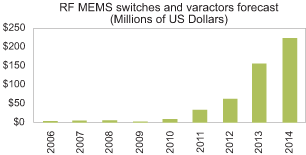
Help may be on the way for Apple iPhone 4 users frustrated by dropped calls with the arrival of radio frequency micro-electromechanical systems (RF MEMS) switches and varactors, semiconductor devices set to undergo rapid shipment growth in the coming years because of their capability to improve the performance of antennas in mobile phones, according to market research firm iSuppli.
Long plagued by technological hurdles and other disappointing setbacks, RF MEMS switches and varactors are finally ready for the big time, with revenues projected to rise dramatically and grow almost fourfold in 2011. From slightly less than $4 million in 2006, global revenue for RF MEMS switches and varactors is anticipated to climb to $8,1 million this year – and then surge to $27,9 million in 2011, iSuppli data shows. By 2014, revenue will reach a whopping $223,2 million – a far cry from the industry’s very modest beginnings.
Like filters, resonators and inductors, switches and varactors are among the devices categorised as RF MEMS. Used in modest volumes in instrumentation for their small form factor and excellent RF performance, RF MEMS switches and varactors nonetheless have failed to take off on a large scale despite initial promise, sinking many companies unable to resolve the myriad commercialisation and technological obstacles.
All that is about to change, market intelligence from iSuppli indicates, as RF MEMS technology reaches a plateau of productivity via strong product offerings from a number of credible companies. Already six firms are sampling. Targeting high-end applications for testing and instrumentation are US entities such as Analog Devices, Radant Technologies and X-COM in cooperation with the relay manufacturer Teledyne Technologies, as well as Japanese-based Omron. On another front, California-based WiSpry and Japan’s TDK-Epcos are aiming for high-volume cellphone applications.
In particular, interest is growing among mobile handset manufacturers on how RF MEMS can be used for the front-end tuning of cellphones to improve antenna performance, given the advent of new wireless standards like LTE for 4G technology. The first mobile handset with tuneable antenna or antenna matching is expected to arrive sometime in the second half of this year, while WiSpry – which has several design wins under its belt with MEMS varactors – is expected to head into serial production by the fourth quarter this year.
By 2014, more than 50% of mobile handsets will feature some level of front-end module tuning, according to iSuppli MEMS research. The implementation of RF MEMS switches and varactors in mobile phones could help boost the performance of smart phones like the iPhone 4, which made news headlines recently because of a problematic antenna that resulted in dropped signal strength.

A couple of smaller – but untapped – opportunities also exist for RF MEMS switches and varactors in the foreseeable future. One area lies in wireless infrastructure (eg, for femtocells) and cellular base stations, where the current switches being used could be outperformed in cost and performance by the new RF MEMS devices. A second area is in defence and aerospace applications – including radio systems – especially after 2014 for phased array antennas, which offer the best high-volume opportunity numbering in the millions of units.
For more information visit www.isuppli.com

© Technews Publishing (Pty) Ltd | All Rights Reserved